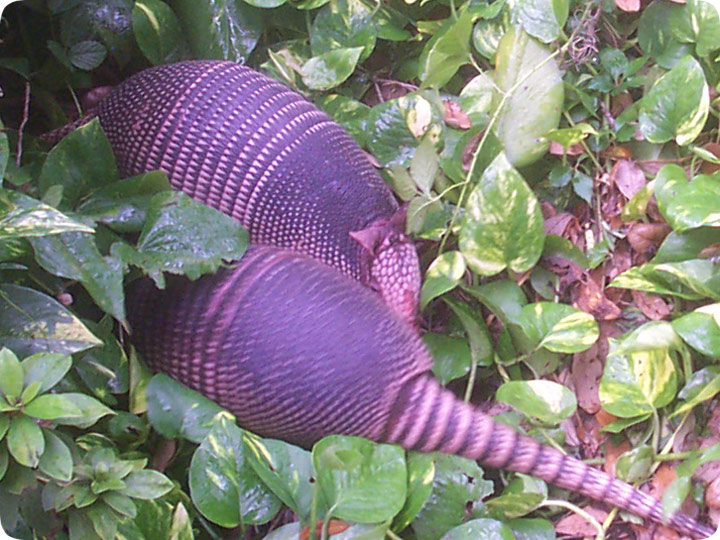-
info@aaanimalcontrol.com
Call us for help in your town
Humane Wildlife Education
Armadillo Hunting in Florida

09.20.2004 - I am an armadillo hunter. There are two types of armadillo hunters. One is a slack jawed yokel who stalks these critters from the back of
a beat-up pickup, shoots it with a 12-gauge, has his dillo hound retrieve the carcass, brings it back and roasts it up for supper, drinks a little moonshine,
and scratches the rosy area between his shoulders and head. The other type of armadillo hunter is an educated professional who sets humane cage traps, removes
the animal in a timely manner, relocates it to wilderness areas, and goes off to a sophisticated dinner of bean sprouts and fine red wine, and caps the evening
off with an intellectual discussion of Wittgenstein over a game of Backgammon. I am the latter. Minus the bean sprouts and backgammon and crap like that.
What
I mean to say is, I don't actually hunt armadillos, I operate a professional armadillo removal business. I actually don't know all of the legalities of hunting
armadillo for sport or food. They aren't native to Florida or Texas or any US state, so they probably aren't protected or regulated in any way. So I guess if
there's any real armadillo hunters out there who crave dillo on the half shell or who just like to kill things for sport, that they can do so unabated. That's
too bad, because I like armadillos, and I'd rather not see them harmed. For armadillo hunting laws, contact your state's fish & game department. For professional
armadillo trapping services, call me in Orlando FL, or check out my nationwide directory of trappers.
Do it yourself: Visit my How To Get Rid of Armadillos page for tips and advice.
Get professional help: Visit my Nationwide Pro Directory of wildlife removal experts.
Trapping Armadillos In The Yard - When you awake in the morning to find that an animal has been digging in your yard or garden, then the culprit will often be an armadillo. These animals aren't always to blame, but tell tale signs such as numerous small holes where they have been digging for insects or a larger hole for a burrow will suggest that it could be an armadillo to blame. There are some people who will make recommendations to kill or repel the armadillo, but the best solution will usually be to trap the animal and then to remove it away from the property.
When it comes to choosing a trap to catch an armadillo in your yard, it will usually be a choice between a snare and a cage trap. Cage traps usually prove to be the most successful because they are much easier to handle, and will prevent the need for the individual to have direct contact with the animal. Once you have successfully trapped the armadillo, you will need to remove the animal, and if you have a flatbed truck available placing the trap in the back is the best solution. Otherwise, you can place the trap in the boot of a car and carry it at least five miles away.
For more wildlife stories, click my Wildlife Blog
or click my below banner to hire a local trapper.
The state of Florida has become a sanctuary for most animals, including armadillos and alligators. Even though armadillos are not native to Florida, you will almost see them anywhere throughout the state, especially at night. These critters can dig burrows around your yard, flower bed, and vegetable garden. They can be a nuisance if you do not get rid of them or keep them off your property. Additionally, some armadillos may carry leprosy that they can transmit to humans who might eat undercooked armadillo meat, or come into contact with them.
Hunting of Armadillos in Florida
With the possible damage and health risk caused by these critters, you may want to hunt and kill them. Some people hunt the armadillos for food or their ornamental shell. However, Florida laws prohibit the hunting of armadillos for any reason. Instead, you are only allowed to trap the nuisance animal and release it on a contiguous property or hand it over to the wildlife services. Therefore, you may be jailed or fined if found guilty of illegally hunting armadillos.
If armadillos have become nuisance animals on your property, you can procure commercially available live traps and capture the stubborn animals and then relocate them a reasonable distance away from your home. If you find the exercise tormenting, you can seek the services of professional wildlife removal in your area if you want to get rid of the critters. However, it's imperative to contact Florida state authorities for permission and advice before going to hunt the armadillos for whatever reason.
Trapping Armadillos in Your Yard
Since armadillos are nuisance animals that can cause extensive damage to your property, you can trap and euthanize or relocate them far from your property. However, Florida law requires that you release the captured animal within the state on a contiguous property. When relocating the animal, ensure that you release in a place with similar conditions as its natural habitat. Otherwise, the critter may not survive in the new environment.
You can trap an armadillo using a cage trap or snare. Cage traps are the most used devices to capture these critters. However, ensure you choose a cage of reasonable size to accommodate armadillos of any size. Some cage traps have one door while others have two doors, all allow the critters to enter from either end. Once it gets trapped, you can relocate the critter to a similar habitat far away from your property.




















